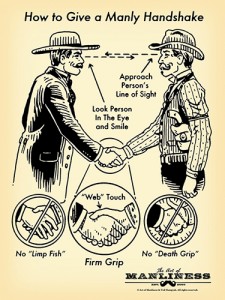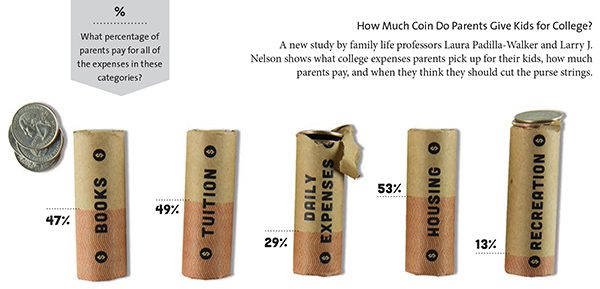A blogging couple shares vintage man skills and gentlemanly virtues with a modern audience.

Creators of The Art of Manliness website and books, husband-and-wife team Brett and Kate McKay turn to bygone eras to help readers rediscover the lost art of manliness.
“Be a man!” “Man up!” “Do it like a man!” Thus shouts the men’s magazine rack, splashed with images of lubed bodybuilders and model-draped millionaires.
Frustrated with such depictions, alumna Kate Surwilo McKay (BA ’03) and her husband, Brett, of Tulsa, Okla., set out to counter the male stereotypes of the superficial, macho brute and the Peter Pan–esque responsibility shirker with their blog, The Art of Manliness.
Capitalizing on the often-quirky “retrosexual” movement, the McKays have turned to the old-fashioned virtues of their grandfathers in an attempt to revive the manly virtues of excellence, resolve, integrity, discipline, and sacrifice. In 2011 they released their second book, Manvotionals: Timeless Wisdom and Advice on Living the Seven Manly Virtues, a thought-provoking companion to their first book, The Art of Manliness: Classic Skills and Manners for the Modern Man, which has sold about 60,000 copies.
“There’ve been a lot of articles these days [asking], ‘What’s happening with men? Is there a place for men in modern society?’” Kate says. “A lot of people out there are feeling sort of lost: they don’t have a sense of purpose in their life, don’t know how to live. They’re really hungry for this kind of knowledge—how to improve themselves, how to be a good person.”
Blending substance with zany humor over a vintage backdrop, The Art of Manliness often draws examples from the “Greatest Generation” and appeals to the frontiersy and gentlemanly past. With posts ranging from career and social tips (like “How to Be a Gentleman at the Office”) to demonstrations (like “How to Carve a Turkey Like a Man”), the blog has hit an untapped niche and reaches more than 135,000 subscribers—racking up over 9 million page views a month. Along with photos and ads dug up from the past, illustrations la 1950s lend the site an aged aesthetic.
To help boys become men, Kate and Brett address problems by providing history, diagnosis, solutions, and encouragement. One lighthearted article, “Unleash the Power of the Nap,” highlights how Edison, JFK, Churchill, and Napoleon were all devoted nappers and extols the benefits of napping. Next it provides a brief explanation of sleep cycles and how to tailor a nap to your needs. “It would be awesome if offices took a cue from kindergarten and broke out cookies, milk, and nap mats once a day,” the McKays write. “Alas, in the real world it can be hard to catch some z’s at work”—so they provide tips on how to squeeze a nap in. More-serious articles discuss topics like finding one’s calling in life and dealing with the death of a loved one.

So now you know how to give a manly handshake. But do you know how to haggle like your old man or field dress a squirrel? In addition to retro illustrations assisting men in the finer points of social skills and fashion, the McKays’ blog shares insights on how to handle careers and finances, relationships and family, health and fitness, and other skills—like a man.
The Art of Manliness breathed its first dapper breath in 2008. Kate, with her master’s in religion from Oklahoma City University, was teaching as an adjunct professor, and Brett was a law student at the University of Tulsa when he penned the debut article, “How to Shave Like Your Grandpa.” Kate stepped in to help after a few months when the blog’s demand got to be too much for Brett to handle alone.
With a mutual love of teaching, researching, and writing, they had planned on becoming full-time professors. So when Brett suggested running the blog as a career instead of taking the bar exam, Kate was more than a bit skeptical. “‘That’s the craziest thing I’ve ever heard!’ I told him. ‘You need to concentrate on your studies and graduate from law school at the top of your class’—and I was totally wrong about that,” she laughs. After three years of juggling full-time jobs, the blog, their first book, and their newborn son, they committed to the blog full-time. And Brett was rescued from taking the bar.
Although guest writers frequent the blog with expertise on topics like dress, career, and survival, Kate and Brett write most of the articles—and they write them together, sending edits back and forth. “Because of my interests, I tend to want to write more historical stuff or heavier philosophical things,” says Kate, who got her bachelor’s in history at BYU. “Brett likes to write more about fun man skills.” You can thank Kate for the meat of “Lessons in Manliness from Atticus Finch” and Brett for the ardent description of his hands-on research learning how to throw a tomahawk.
“We definitely choose a wide spectrum of topics,” says Kate. “One day we’ll have”—“pirate knowledge,” Brett supplies—“the next day we’ll have something about relationships and then how to fold a pocket square and then how to cut down a tree.” Because of the variety, the blog has a broad appeal.
Thousands of women also follow the blog. “It’s not really a blog about gender,” Kate says. “It’s a blog about growing up into a good adult.”
Although the McKays are members of the Church, The Art of Manliness is not overtly religious. “We really try to keep it open for everyone,” says Kate. “We take stuff about virtues and being a good person, incorporate gospel principles, and then put it in a way that everyone can grasp.”
Membership in the Church has given the McKays a solid framework for authoring the blog. “The Church does a really good job of socializing young men into manhood,” Brett says. “From the very beginning we learn how to tie a tie, speak in public, dance, show proper etiquette toward a woman, date, foster a relationship.”
Kate agrees: “Mormonism is so practical. Be kind, be honest, don’t go into debt, and forgive people. People have been bereft of that kind of schooling for basic life skills.”
In order to research, write, and post four or five times a week, Kate and Brett occasionally pull all-nighters and avoid taking vacations or sick days. “There is no clocking-out time,” says Kate. But the blessing of helping people live more fulfilling lives far outweighs the sacrifices. “We really want to inspire people, help better and improve their lives, but also to entertain and just be fun sometimes,” Kate says.
Positive feedback comes from all types of readers: inner-city teens with single moms, soldiers coping with PTSD, counselors in juvenile detention centers. “We get the nicest e-mails and letters from people,” says Kate. “They say the site has changed their lives and made them a better person. When you hear that from people, you do feel a great responsibility. I think, OK, I have to keep doing a good job, and I can’t give up.”
— Krista Holmes Hanby (BA ’11)









